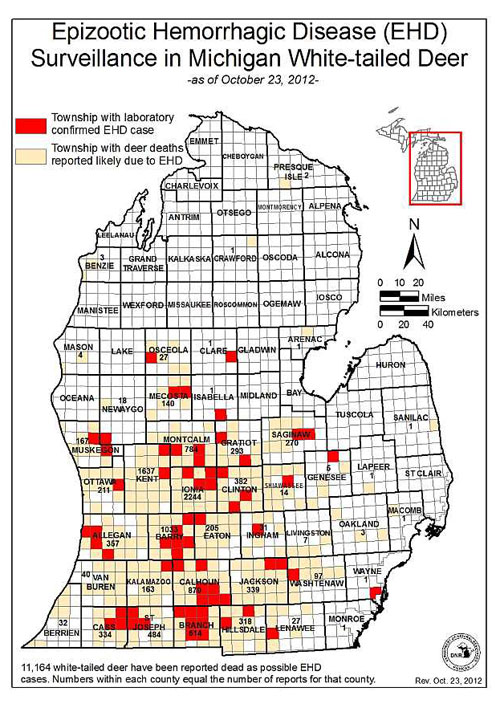Epizootic hemorrhagic disease, or EHD, is an acute, infectious, viral disease found in wild ruminants like whitetail deer. It is spread by the bite of a tiny fly called a midge, and is usually fatal to the infected deer within a couple of weeks after its transmission.
This year, because of an unusually mild winter combined with an unseasonably dry summer, an outbreak of EHD has hit a region of the upper Midwest especially hard, an area that has never endured a deer die-off from the disease to the extent it has in recent months.
 As a result, early season bowhunters in parts of Michigan, northern Illinois, southern Wisconsin and North Dakota made some gruesome discoveries when they first headed afield in late summer and early fall – usually smelling the carcasses of rotting whitetail before seeing them.
As a result, early season bowhunters in parts of Michigan, northern Illinois, southern Wisconsin and North Dakota made some gruesome discoveries when they first headed afield in late summer and early fall – usually smelling the carcasses of rotting whitetail before seeing them.
The impact of this year’s EHD outbreak has also adversely affected archery and hunting gear retailers in some regions, most notably in the southern half of Michigan, where the disease has claimed deer by the thousands.
The Michigan Department of Natural Resources announced this week that EHD has been confirmed in 30 counties, including Allegan, Barry, Branch, Calhoun, Cass, Clare, Clinton, Eaton, Genesee, Gratiot, Hillsdale, Ingham, Ionia, Isabella, Jackson, Kalamazoo, Kent, Lenawee, Manistee, Mecosta, Montcalm, Muskegon, Newaygo, Osceola, Ottawa, Saginaw, Shiawassee, St. Joseph, Washtenaw, and Wayne.
A total of 11,164 dead whitetails – presumably killed by EHD – have been reported to the agency, with the emphasis on the word “reported.”
“They say to get an accurate idea of how many deer have died is to multiply that number by seven or nine,” Chad Perkins, archery retailer and owner of Gold Star 2 in Lake Odessa told The Archery Wire in an interview Monday, Oct. 29.
Ionia County, where Perkins has operated his archery, firearms and hunting gear business for the past six years, currently leads the state with 2,244 reported deer deaths from EHD in 2012.
“Everybody who comes into the shop is talking about it,” Perkins said. “And even though we’ve had a few freezes (which kill the biting midges that spread the disease), hunters are still finding dead deer.”
Perkins estimates that he’s seen about a 10 to 15 percent decline in sales, directly attributed to this year’s EHD outbreak. Other area business like restaurants and motels have been negatively impacted as well, because many hunters simply aren’t hunting this year or are traveling elsewhere to do so.
Tom Cooley, a biologist and pathologist with the Michigan DNR’s Wildlife Disease Lab said there is more than one strain of EHD, and unless the deer herd has been exposed to a specific strain, it has little built-up resistance or immunity to that virus.
“Historically, this has been a fairly isolated disease,” said Cooley. “This year, we are likely dealing with a population of deer that have not been exposed to this disease, so no natural vaccination has taken place,” he said. “That’s likely why we are seeing higher mortality and morbidity rates.”
Prior to this year, Michigan’s most severe outbreak of EHD was in 2010, when an estimated 1,000 animals died in six counties, a far cry for the low-end estimate of 11,000 so far this year.
Jeff Schantz, an employee of Al and Pete’s Sports Shop in Hastings, Mich. told the Detroit News last week the shop had a disappointing archery season.
“It’s definitely hurt us,” said Schantz. “Gun sales, bow sales, crossbow sales, arrows, broadheads, slugs … you name it, the numbers are down. Some people aren’t even going to hunt this year.”
— JR Absher, The Archery Wire
(Visit www.TheArcheryWire.com to register to receive weekly email updates about archery-related news from across the country.)
